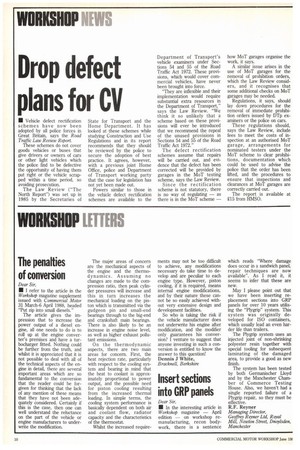Drop defect plans for CV
Page 106

If you've noticed an error in this article please click here to report it so we can fix it.
• Vehicle defect rectification schemes have now been adopted by all police forces in Great Britain, says the Road Traffic Law Review Report These schemes do not cover goods vehicles or buses that give drivers or owners of cars or other light vehicles which the police find to be defective the opportunity of having them put right or the vehicle scrapped within a time period, so avoiding prosecution.
The Law Review ("The North Report") was set up in 1985 by the Secretaries of State for Transport and the Home Department. It has looked at these schemes while studying Construction and Use Regulations and in its report recommends that they should be reviewed by the police to secure the adoption of best practice. It agrees, however, with a previous joint Home Office, police and Department of Transport working party that the case for legislation has not yet been made out.
Powers similar to those in the vehicle defect rectification schemes are available to the Department of Transport's vehicle examiners under Sections 54 and 55 of the Road Traffic Act 1972. These provisions, which would cover commercial vehicles, have never been brought into force.
"They are inflexible and their implementation would require substantial extra resources in the Department of Transport," says the Law Review. "We think it so unlikely that a scheme based on these provisions will ever be introduced that we recommend the repeal of the unused provisions in Sections 54 and 55 of the Road Traffic Act 1972."
The defect rectification schemes assume that repairs will be carried out, and evidence that the defect has been corrected will be provided by garages in the MoT testing scheme, says the Law Review.
Since the rectification scheme is not statutory, there is no way of regulating — as there is in the MoT scheme — how MoT garages organise the work, it says.
A similar issue arises in the use of MoT garages for the removal of prohibition orders, which the Law Review considers, and it recognises that some additional checks on MoT garages may be needed.
Regulations, it says, should lay down procedures for the removal of immediate prohibition orders issued by DTp examiners or the police on cars.
These regulations should, says the Law Review, include fees to meet the costs of inspection at an authorised MoT garage, arrangements for nominated testers under the MoT scheme to clear prohibitions, documentation which could be used to advise the police that the order has been lifted, and the procedures to ensure that inspections and clearances at MoT garages are correctly carried out.
The report is available at £15 from HMSO.




































































































































